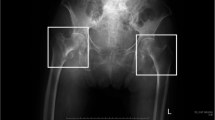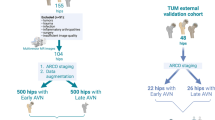Abstract
Purpose
The aim of this study was to develop a deep convolutional neural network (DCNN) for detecting early osteonecrosis of the femoral head (ONFH) from various hip pathologies and evaluate the feasibility of its application.
Methods
We retrospectively reviewed and annotated hip magnetic resonance imaging (MRI) of ONFH patients from four participated institutions and constructed a multi-centre dataset to develop the DCNN system. The diagnostic performance of the DCNN in the internal and external test datasets was calculated, including area under the receiver operating characteristic curve (AUROC), accuracy, precision, recall, and F1 score, and gradient-weighted class activation mapping (Grad-CAM) technique was used to visualize its decision-making process. In addition, a human–machine comparison trial was performed.
Results
Overall, 11,730 hip MRI segments from 794 participants were used to develop and optimize the DCNN system. The AUROC, accuracy, and precision of the DCNN in internal test dataset were 0.97 (95% CI, 0.93–1.00), 96.6% (95% CI: 93.0–100%), and 97.6% (95% CI: 94.6–100%), and in external test dataset, they were 0.95 (95% CI, 0.91– 0.99), 95.2% (95% CI, 91.1–99.4%), and 95.7% (95% CI, 91.7–99.7%). Compared with attending orthopaedic surgeons, the DCNN showed superior diagnostic performance. The Grad-CAM demonstrated that the DCNN placed focus on the necrotic region.
Conclusion
Compared with clinician-led diagnoses, the developed DCNN system is more accurate in diagnosing early ONFH, avoiding empirical dependence and inter-reader variability. Our findings support the integration of deep learning systems into real clinical settings to assist orthopaedic surgeons in diagnosing early ONFH.




Similar content being viewed by others
Data availability
All materials and data generated from this study are available upon request to the corresponding author.
Code availability
The code included in this study is available upon request to the corresponding author.
References
Mont MA, Zywiel MG, Marker DR, McGrath MS, Delanois RE (2010) The natural history of untreated asymptomatic osteonecrosis of the femoral head: a systematic literature review. J Bone Joint Surg Am 92(12):2165–2170. https://doi.org/10.2106/jbjs.i.00575
Liu LH, Li ZR, Sun W, Wang YT, Gao FQ (2022) Reliability and repeatability of the China-Japan Friendship Hospital typing classification for nontraumatic osteonecrosis of the femoral head. J Bone Joint Surg Am 104(Suppl 2):40–46. https://doi.org/10.2106/JBJS.20.00051
Microsurgery Department of the Orthopedics Branch of the Chinese Medical Doctor A, Group from the O, Bone Defect Branch of the Chinese Association of R, Reconstructive S, Microsurgery, Reconstructive Surgery Group of the Orthopedics Branch of the Chinese Medical A (2017) Chinese guideline for the diagnosis and treatment of osteonecrosis of the femoral head in adults. Orthop Surg 9(1):3–12. https://doi.org/10.1111/os.12302
Zhao D, Zhang F, Wang B, Liu B, Li L, Kim SY, Goodman SB, Hernigou P, Cui Q, Lineaweaver WC, Xu J, Drescher WR, Qin L (2020) Guidelines for clinical diagnosis and treatment of osteonecrosis of the femoral head in adults (2019 version). J Orthop Translat 21:100–110. https://doi.org/10.1016/j.jot.2019.12.004
Chen ZW, Li TX, Wan XX, Wang RT, Chen WH (2017) Study on the risk factors for the misdiagnosis of femoral head osteonecrosis. Zhongguo Gu Shang 30(11):1000–1003. https://doi.org/10.3969/j.issn.1003-0034.2017.11.006
Li WL, Tan B, Jia ZX, Dong B, Huang ZQ, Zhu RZ, Zhao W, Gao HH, Wang RT, Chen WH (2020) Exploring the risk factors for the misdiagnosis of osteonecrosis of femoral head: a case-control study. Orthop Surg 12(6):1792–1798. https://doi.org/10.1111/os.12821
Wei QS, Li ZQ, Hong ZN, Hong GJ, Pang FX, Yang P, Yang F, Yuan YJ, Zhuang ZK, He W (2022) Predicting collapse in osteonecrosis of the femoral head using a new method: preserved angles of anterior and lateral femoral head. J Bone Joint Surg Am 104(Suppl 2):47–53. https://doi.org/10.2106/jbjs.20.00507
Xie X, Xiao YF, Zhao XY, Li JJ, Yang QQ, Peng X, Nie XB, Zhou JY, Zhao YB, Yang H, Liu X, Liu E, Chen YY, Zhou YY, Fan CQ, Bai JY, Lin H, Koulaouzidis A, Yang SM (2022) Development and validation of an artificial intelligence model for small bowel capsule endoscopy video review. JAMA Netw Open 5(7):e2221992. https://doi.org/10.1001/jamanetworkopen.2022.21992
Bos JM, Attia ZI, Albert DE, Noseworthy PA, Friedman PA, Ackerman MJ (2021) Use of artificial intelligence and deep neural networks in evaluation of patients with electrocardiographically concealed long QT syndrome from the surface 12-lead electrocardiogram. JAMA Cardiol 6(5):532–538. https://doi.org/10.1001/jamacardio.2020.7422
Monchka BA, Kimelman D, Lix LM, Leslie WD (2021) Feasibility of a generalized convolutional neural network for automated identification of vertebral compression fractures: the Manitoba Bone Mineral Density Registry. Bone 150:116017. https://doi.org/10.1016/j.bone.2021.116017
Jopling JK, Pridgen BC, Yeung S (2021) Deep convolutional neural networks as a diagnostic aid-a step toward minimizing undetected scaphoid fractures on initial hand radiographs. JAMA Netw Open 4(5):e216393. https://doi.org/10.1001/jamanetworkopen.2021.6393
Schwartz AJ, Clarke HD, Spangehl MJ, Bingham JS, Etzioni DA, Neville MR (2020) Can a convolutional neural network classify knee osteoarthritis on plain radiographs as accurately as fellowship-trained knee arthroplasty surgeons? J Arthroplasty 35(9):2423–2428. https://doi.org/10.1016/j.arth.2020.04.059
Han Q, Wang C, Chen H, Zhao X, Wang J (2019) Porous tantalum and titanium in orthopedics: a review. ACS Biomater Sci Eng 5(11):5798–5824
Yoon BH, Mont MA, Koo KH, Chen CH, Cheng EY, Cui Q, Drescher W, Gangji V, Goodman SB, Ha YC, Hernigou P, Hungerford MW, Iorio R, Jo WL, Jones LC, Khanduja V, Kim HKW, Kim SY, Kim TY, Lee HY, Lee MS, Lee YK, Lee YJ, Nakamura J, Parvizi J, Sakai T, Sugano N, Takao M, Yamamoto T, Zhao DW (2020) The 2019 revised version of Association Research Circulation Osseous staging system of osteonecrosis of the femoral head. J Arthroplasty 35(4):933–940. https://doi.org/10.1016/j.arth.2019.11.029
Huang G, Liu Z, Van Der Maaten L, Weinberger KQ (2017) Densely connected convolutional networks. In: 2017 Proc IEEE Conf Comput Vis Pattern Recognit (CVPR), pp 2261–2269. https://doi.org/10.1109/CVPR.2017.243
Zhang H, Cisse M, Dauphin YN, Lopez-Paz D (2017) Mixup: beyond empirical risk minimization. arXiv preprint arXiv:171009412. https://doi.org/10.48550/arXiv.1710.09412
Malizos KN, Karantanas AH, Varitimidis SE, Dailiana ZH, Bargiotas K, Maris T (2007) Osteonecrosis of the femoral head: etiology, imaging and treatment. Eur J Radiol 63(1):16–28. https://doi.org/10.1016/j.ejrad.2007.03.019
Joint Surgery Group of the Orthopaedic Branch of the Chinese Medical A (2015) Guideline for diagnostic and treatment of osteonecrosis of the femoral head. Orthop Surg 7(3):200–207. https://doi.org/10.1111/os.12193
Vosshenrich J, Brantner P, Cyriac J, Boll DT, Merkle EM, Heye T (2021) Quantifying radiology resident fatigue: analysis of preliminary reports. Radiology 298(3):632–639. https://doi.org/10.1148/radiol.2021203486
Bærøe K, Miyata-Sturm A, Henden E (2020) How to achieve trustworthy artificial intelligence for health. Bull World Health Organ 98(4):257–262. https://doi.org/10.2471/blt.19.237289
Gore JC (2020) Artificial intelligence in medical imaging. Magn Reson Imaging 68:A1-a4. https://doi.org/10.1016/j.mri.2019.12.006
Hardy M, Harvey H (2020) Artificial intelligence in diagnostic imaging: impact on the radiography profession. Br J Radiol 93(1108):20190840. https://doi.org/10.1259/bjr.20190840
Farrow L, Zhong M, Ashcroft GP, Anderson L, Meek RMD (2021) Interpretation and reporting of predictive or diagnostic machine-learning research in Trauma & Orthopaedics. Bone Joint J 103-b(12):1754–1758. https://doi.org/10.1302/0301-620x.103b12.bjj-2021-0851.r1
Ko S, Pareek A, Ro DH, Lu Y, Camp CL, Martin RK, Krych AJ (2022) Artificial intelligence in orthopedics: three strategies for deep learning with orthopedic specific imaging. Knee Surg Sports Traumatol Arthrosc 30(3):758–761. https://doi.org/10.1007/s00167-021-06838-8
Cheng C-T, Ho T-Y, Lee T-Y, Chang C-C, Chou C-C, Chen C-C, Chung IF, Liao C-H (2019) Application of a deep learning algorithm for detection and visualization of hip fractures on plain pelvic radiographs. Eur Radiol 29(10):5469–5477. https://doi.org/10.1007/s00330-019-06167-y
Chung SW, Han SS, Lee JW, Oh KS, Kim NR, Yoon JP, Kim JY, Moon SH, Kwon J, Lee HJ, Noh YM, Kim Y (2018) Automated detection and classification of the proximal humerus fracture by using deep learning algorithm. Acta Orthop 89(4):468–473. https://doi.org/10.1080/17453674.2018.1453714
Zhang SC, Sun J, Liu CB, Fang JH, Xie HT, Ning B (2020) Clinical application of artificial intelligence-assisted diagnosis using anteroposterior pelvic radiographs in children with developmental dysplasia of the hip. Bone Joint J 102-b(11):1574–1581. https://doi.org/10.1302/0301-620x.102b11.bjj-2020-0712.r2
Park HS, Jeon K, Cho YJ, Kim SW, Lee SB, Choi G, Lee S, Choi YH, Cheon JE, Kim WS, Ryu YJ, Hwang JY (2021) Diagnostic performance of a new convolutional neural network algorithm for detecting developmental dysplasia of the hip on anteroposterior radiographs. Korean J Radiol 22(4):612–623. https://doi.org/10.3348/kjr.2020.0051
Xu W, Shu L, Gong P, Huang C, Xu J, Zhao J, Shu Q, Zhu M, Qi G, Zhao G, Yu G (2021) A deep-learning aided diagnostic system in assessing developmental dysplasia of the hip on pediatric pelvic radiographs. Front Pediatr 9:785480. https://doi.org/10.3389/fped.2021.785480
Zhu L, Han J, Guo R, Wu D, Wei Q, Chai W, Tang S (2020) An automatic classification of the early osteonecrosis of femoral head with deep learning. Curr Med Imaging 16(10):1323–1331. https://doi.org/10.2174/1573405615666191212104639
Wang P, Liu X, Xu J, Li T, Sun W, Li Z, Gao F, Shi L, Li Z, Wu X, Xu X, Fan X, Li C, Zhang Y, An Y (2021) Deep learning for diagnosing osteonecrosis of the femoral head based on magnetic resonance imaging. Comput Methods Programs Biomed 208:106229. https://doi.org/10.1016/j.cmpb.2021.106229
Shen X, Luo J, Tang X, Chen B, Qin Y, Zhou Y, Xiao J (2022) Deep learning approach for diagnosing early osteonecrosis of the femoral head based on magnetic resonance imaging. J Arthroplasty. https://doi.org/10.1016/j.arth.2022.10.003
Kim DW, Jang HY, Kim KW, Shin Y, Park SH (2019) Design characteristics of studies reporting the performance of artificial intelligence algorithms for diagnostic analysis of medical images: results from recently published papers. Korean J Radiol 20(3):405–410. https://doi.org/10.3348/kjr.2019.0025
Rosa C, Marsch LA, Winstanley EL, Brunner M, Campbell ANC (2021) Using digital technologies in clinical trials: current and future applications. Contemp Clin Trials 100:106219. https://doi.org/10.1016/j.cct.2020.106219
Erhan D, Bengio Y, Courville AC, Vincent P (2009) Visualizing higher-layer features of a deep network. University of Montreal 1341(3):1
Acknowledgements
We thank the review panel members in our study who reviewed the MRI scan data we included and the radiologists at the four participated institutions for their guidance and assistance.
Funding
This work was supported by funding from the Key Project of the National Natural Science Foundation of China (No.: U21A20390), Jilin Scientific and Technological Development Program (No.:20230203089SF), Natural Science Foundation of Jilin Province (No.: 20200201536JC), and the Project of Jilin Provincial Department of Finance (No.: 2020SCZ63).
Author information
Authors and Affiliations
Contributions
Concept and design: Shen, Xiao, and Qin.
Expert orthopaedic surgeons read: Xiao, Liu, and Qin.
Collection and curation of the clinical datasets: Shen, Shi, Yang, Chen, and Tang.
Development, training, validation, and optimization of convolutional neural networks: He, Luo, and Zhou.
Data analysis and interpretation: Shen, Xu, Chen, and Tang.
Drafting of the manuscript: Shen, Xu, Chen, and Tang.
Critical analysis and manuscript revision: all authors.
All the authors read and approved the final manuscript.
Corresponding authors
Ethics declarations
Ethics approval
Institutional ethical board review was obtained for the present study (No: SB2021-012).
Consent to participate
Informed consent was waived because materials of included patients were anonymized and desensitized.
Consent for publication
Informed consent was waived because materials of included patients were anonymized and desensitized.
Competing interests
The authors declare no competing interests.
Additional information
Publisher's note
Springer Nature remains neutral with regard to jurisdictional claims in published maps and institutional affiliations.
Investigation performed at The Second Hospital of Jilin University, Changchun, China.
Supplementary information
Below is the link to the electronic supplementary material.
Rights and permissions
Springer Nature or its licensor (e.g. a society or other partner) holds exclusive rights to this article under a publishing agreement with the author(s) or other rightsholder(s); author self-archiving of the accepted manuscript version of this article is solely governed by the terms of such publishing agreement and applicable law.
About this article
Cite this article
Shen, X., He, Z., Shi, Y. et al. Automatic detection of early osteonecrosis of the femoral head from various hip pathologies using deep convolutional neural network: a multi-centre study. International Orthopaedics (SICOT) 47, 2235–2244 (2023). https://doi.org/10.1007/s00264-023-05813-x
Received:
Accepted:
Published:
Issue Date:
DOI: https://doi.org/10.1007/s00264-023-05813-x




